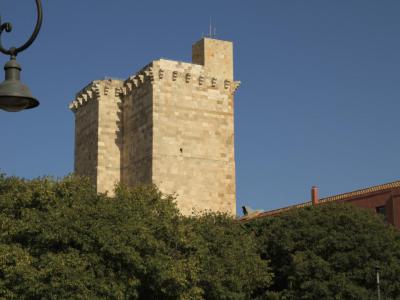
Torre di San Pancrazio (Tower of San Pancrazio), Cagliari
The Tower of San Pancrazio is the tallest medieval tower in Cagliari, standing as a symbol of the city’s Pisan heritage. Built in 1305 under the direction of architect Giovanni Capula, the tower was constructed during the Pisan domination (1258-1326) to fortify the Castello district, the city’s political, military, and religious hub. Located at Cagliari’s highest point, the tower offers breathtaking panoramic views of the city and the surrounding coastline.
It is made of Pietra Forte, a white limestone extracted from the Bonaria Hill, and features three enclosed sides with narrow slits for defense, while the fourth side remains open, exposing the interior galleries. Along with the Elephant Tower, it served as a key defensive structure, securing the main access points to Castello. It played a crucial role in mapping Sardinia, as Piedmontese general Alberto Della Marmora used the tower as a zero point to create the island’s first geographical map in the 19th century.
Following the Aragonese conquest of Sardinia (1323-1327), the south side of the tower was enclosed, repurposing its interior as warehouses and residences for Spanish officials. By the 16th century, the construction of the Dusay Bastion diminished its strategic importance, and the tower was transformed into a prison, a role it maintained until the late 19th century. In 1903, extensive restoration efforts were undertaken to return the structure to its original Pisan-era condition.
Today, visitors to the Tower of San Pancrazio can explore its historic architecture, admire the coat of arms of Pisan castellans embedded in its walls, and walk along its wooden mezzanines, reconstructed during 20th-century restorations. Though its original wooden doors and iron-covered shutters have been lost, the 35 stone corbels that once supported a wooden balcony remain intact. The tower’s name is believed to originate from the nearby Church of San Lorenzo, which was dedicated to San Pancrazio during the Pisan era.
It is made of Pietra Forte, a white limestone extracted from the Bonaria Hill, and features three enclosed sides with narrow slits for defense, while the fourth side remains open, exposing the interior galleries. Along with the Elephant Tower, it served as a key defensive structure, securing the main access points to Castello. It played a crucial role in mapping Sardinia, as Piedmontese general Alberto Della Marmora used the tower as a zero point to create the island’s first geographical map in the 19th century.
Following the Aragonese conquest of Sardinia (1323-1327), the south side of the tower was enclosed, repurposing its interior as warehouses and residences for Spanish officials. By the 16th century, the construction of the Dusay Bastion diminished its strategic importance, and the tower was transformed into a prison, a role it maintained until the late 19th century. In 1903, extensive restoration efforts were undertaken to return the structure to its original Pisan-era condition.
Today, visitors to the Tower of San Pancrazio can explore its historic architecture, admire the coat of arms of Pisan castellans embedded in its walls, and walk along its wooden mezzanines, reconstructed during 20th-century restorations. Though its original wooden doors and iron-covered shutters have been lost, the 35 stone corbels that once supported a wooden balcony remain intact. The tower’s name is believed to originate from the nearby Church of San Lorenzo, which was dedicated to San Pancrazio during the Pisan era.
Want to visit this sight? Check out these Self-Guided Walking Tours in Cagliari. Alternatively, you can download the mobile app "GPSmyCity: Walks in 1K+ Cities" from Apple App Store or Google Play Store. The app turns your mobile device to a personal tour guide and it works offline, so no data plan is needed when traveling abroad.
Torre di San Pancrazio (Tower of San Pancrazio) on Map






Sight Name: Torre di San Pancrazio (Tower of San Pancrazio)
Sight Location: Cagliari, Italy (See walking tours in Cagliari)
Sight Type: Attraction/Landmark
Guide(s) Containing This Sight:
Sight Location: Cagliari, Italy (See walking tours in Cagliari)
Sight Type: Attraction/Landmark
Guide(s) Containing This Sight:
Walking Tours in Cagliari, Italy
Create Your Own Walk in Cagliari
Creating your own self-guided walk in Cagliari is easy and fun. Choose the city attractions that you want to see and a walk route map will be created just for you. You can even set your hotel as the start point of the walk.
Cagliari Introduction Walking Tour
Welcome to Cagliari, Sardinia’s beating heart! Perched along the shimmering Mediterranean, this sun-soeaked city blends centuries-old history with modern charm. With stunning beaches, colorful lagoons, and lush greenery, it’s also a place where natural beauty meets cultural riches.
Cagliari’s story began long before our time. Around the 8th century BC, the Phoenicians founded Karaly as a... view more
Tour Duration: 2 Hour(s)
Travel Distance: 2.9 Km or 1.8 Miles
Cagliari’s story began long before our time. Around the 8th century BC, the Phoenicians founded Karaly as a... view more
Tour Duration: 2 Hour(s)
Travel Distance: 2.9 Km or 1.8 Miles

